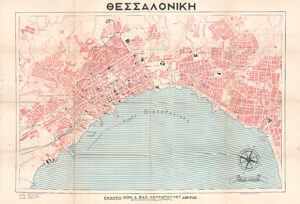The transformations of Thessaloniki
City
Migration Period
Category
Full Description
By 1936, refugee settlement in Thessaloniki had almost been completed. The city, depicted on this map from that same year, had changed radically both from a spatial and an anthropogeographical perspective. Within 20 years it had doubled in size, from 900 hectares in 1920 to 2,000 in 1940, and its population had increased by 64%, from 174,390 in 1920 to 273,635 in 1940. This population growth encompasses the settlement of the refugees (about 120,000 in 1928), but also reflects the departure of the Muslim population in 1924 (which numbered approximately 25,000 people in 1920), as well as the exodus of many Jewish residents towards Western Europe, South America and Palestine (the Jewish population of the city amounted to approximately 70,000 people in 1920, dropping to 50,000 twenty years later).
Until 1928, during the first years of the refugee settlement process, most refugees resided in the city centre or the surrounding areas. At the end of the 1920s, however, many refugees were motivated to move to the suburbs or to areas previously inhabited by Muslims, like Ano Poli, for two reasons. The first reason was the success of the efforts made by the Greek state and the Refugee Settlement Commission to boost housing construction in the suburbs both directly (by constructing houses) and indirectly (by ceding land), resulting in the construction of approximately 12,000 houses between 1924 and 1932. The second reason was that, by 1928, the reconstruction of the area destroyed by the Great Fire of 1917 had been completed, leading to an increase in real estate prices in the city centre, while a large number of exchangeable properties were being auctioned off, especially in Ano Poli, which was transformed from a middle-class quarter into a cheap, crowded refugee neighbourhood.
In the years between 1923 and 1934, more than 50 settlements in total were established around the centre of Thessaloniki. More than 20 of them were established by the Ministry of Welfare, 8 by housing associations using land granted by the Ministry of Welfare, 14 by the Refugee Settlement Commission (these were mostly agrarian settlements), 2 were built on private initiative and several were temporary or illegal settlements which were then either legitimised or disbanded.
Settlement construction often circumvented pre-existing laws, as it was supervised by the Ministry of Welfare and the Refugee Settlement Commission. The approved plan for the city’s expansion was ignored and settlements were planned according to land availability and the need to ensure their independence from the pre-existing city.
Within 20 years, Thessaloniki was transformed from a city organised according to its national communities to a city characterised by socio-economic stratification. This transformation was facilitated by several factors: the fact that Thessaloniki no longer belonged to an empire and was now part of a nation-state, the effects of a huge, destructive fire, and the largest population movement that had ever taken place until then.
On the map, from West to East, we can discern the settlements Ampelokipoi, Eptalofos, Kallithea, Sykies, Agios Pavlos, Evangelistria, Saranta Ekklisies, Agia Foteini, Triandria, Ano and Kato Toumba and Charilaou. After the mass construction that took place post-war, these suburbs look completely different from what they did in the interwar period. While in cities like Volos, Piraeus and Athens, there are still residential clusters which remain as traces of that massive housing rehabilitation project, it is really hard to find their equivalents in modern Thessaloniki.
Bibliography
Vilma Hastaoglou, ‘Refugee settlement. Social and spatial formations’, in Eleni Ioannidou (ed.), The Transformation of Thessaloniki. Refugee settlement in the city (1920-1940), seminar proceedings, May 17 2008, Historical Archive of Refugee Hellenism, ‘Friends of ASKI’ Society, Epikentro, Thessaloniki 2010, pp. 43-88.
Evanghelos Hekimoglou, ‘Sites of Refugees’ Establishment in Thessaloniki, 1922-1927’, in The political history and cultural creativity of Asia Minor Greeks from classic antiquity to our times, 2nd Panhellenic Conference on Asia Minor Hellenism, Vanias Publications, Thessaloniki 1994, pp. 149-173.
Paris Savvaidis, ‘Mapping the refugee settlements in Thessaloniki during the first thirty years of the 20thcentury’, in Thalis, Tribute volume dedicated to Professor Emeritus Michail E. Kontadakis, School of Rural and Surveying Engineering, Aristotle University of Thessaloniki, Thessaloniki 2013, pp. 341-358.

